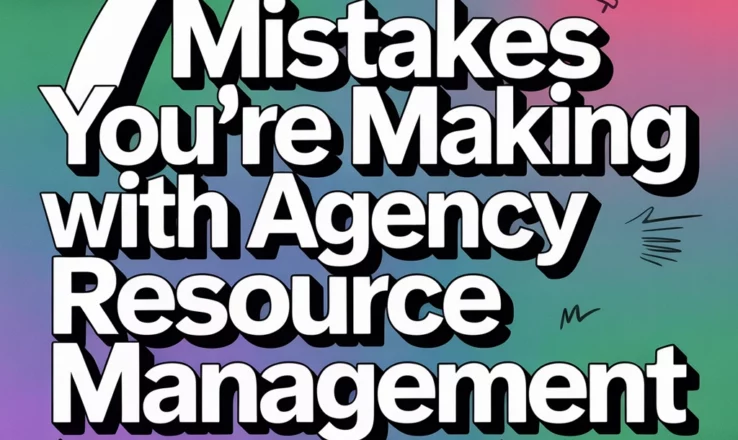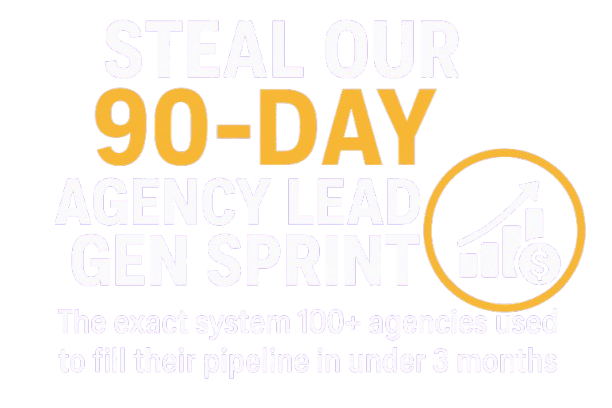
Here's the brutal truth: your resource management is probably costing you more money than you think. After working with hundreds of agency founders, I've seen the same seven mistakes destroy profit margins, burn out teams, and kill client relationships over and over again.
But here's the good news, every single one of these mistakes is fixable. Today, we're going to walk through each one, show you exactly why it's bleeding your agency dry, and give you the step-by-step framework to fix it immediately.
Get ready to get your hands dirty. This isn't theory, it's the exact process I use with $5M+ agencies to turn resource chaos into profit machines.
Mistake #1: Flying Blind on Resource Requirements
This is where most agencies die a slow death. You're taking on projects without clearly defining what resources you actually need, the specific skills, tools, team members, and timelines required to deliver exceptional results.
Here's what happens: Your project manager promises the client a comprehensive social media strategy. Day one arrives, and suddenly you realize you need a graphic designer who understands TikTok trends, a copywriter with B2B SaaS experience, and video editing software your team has never touched. Panic mode activated.
The real cost? Projects that should take 4 weeks stretch to 8. Your team works overtime. Client gets frustrated. You eat the additional hours to maintain the relationship. Your margin just evaporated.
Here's how to fix it right now:
Before you sign another contract, create a Resource Requirements Matrix for every service you offer. Break it down like this:
- Core team roles needed (specific titles, not "someone who can handle marketing")
- Skill requirements (not just "social media experience" but "Instagram Reels creation with 100K+ average views")
- Technology stack (every tool, software license, and platform access required)
- Timeline dependencies (which resources are needed when, and for how long)
Document this once, use it forever. No more surprises.

Mistake #2: The Talent Shuffle Disaster
You're putting your A-players on grunt work and leaving junior team members to handle complex strategy sessions. This is resource allocation malpractice, and it's costing you serious money.
I see this constantly: agencies assign their senior strategist to compile social media reports while a new hire presents campaign strategy to a $50K/month client. The math doesn't add up, and neither do your results.
The fix is systematic resource matching:
Create a Skills Inventory Dashboard that tracks three things for every team member:
- Current utilization rate (how busy they are right now)
- Skill level ratings (1-10 for each competency area)
- Project preferences (what energizes them vs. what drains them)
Now match resources to tasks based on complexity, not availability. Your senior strategist should be architecting campaigns, not formatting PowerPoints. Period.
Pro tip: Build this into your project planning process. Every task gets a required skill level. Every team member gets assigned based on skill match first, availability second.
Mistake #3: Winging It Without a Resource Plan
Fifty percent of agencies can't forecast resource needs beyond two months. That means half the industry is basically playing resource roulette with client deliverables and team sanity.
When you don't have a resource management plan, you're operating in constant crisis mode. Projects overlap unexpectedly. Team members get triple-booked. Quality suffers. Clients notice.
Here's your resource planning framework:
Step 1: Map every project's resource lifecycle
- Kickoff phase requirements (who, what, when)
- Execution phase resources (peak capacity periods)
- Review and revision cycles (who needs to be available when)
- Delivery and handoff resources
Step 2: Create a 90-day resource forecast
- Plot every active project's resource demands
- Identify capacity gaps before they become crises
- Plan hiring or contractor needs 6-8 weeks in advance
Step 3: Build buffer time into every plan
- Add 20% padding for scope creep
- Account for revision cycles
- Plan for sick days and vacations
This takes 2 hours to set up. It saves you 20 hours of crisis management per month.

Mistake #4: Flying Blind on Actual Usage
You budget 40 hours for a campaign strategy. Your team actually spends 65 hours. You have no system to track this gap, learn from it, or price future projects accurately. This is how agencies go broke slowly.
Without resource tracking, you're making the same estimation mistakes repeatedly. You can't improve what you don't measure.
Implement these tracking systems immediately:
Time tracking that actually works:
- Use project-specific tracking codes
- Break tasks into 30-minute increments minimum
- Require daily time entry (not weekly catch-up sessions)
Cost attribution tracking:
- Track both internal time and external costs per project
- Monitor actual vs. budgeted resources weekly
- Create variance reports that show exactly where estimates were off
The payoff: After 6 months of consistent tracking, your project estimates will be accurate within 10%. Your profit margins will thank you.
Mistake #5: Terrible Resource Forecasting
Your forecasting probably sounds like this: "We'll need someone on design for this project." That's not forecasting, that's hoping.
Proper resource forecasting means predicting exactly what skill sets you'll need, when you'll need them, and for how long. It's the difference between scrambling to hire freelancers mid-project and having the right team ready to execute.
Build a forecasting system that actually works:
Historical data analysis:
- Review your last 20 projects
- Calculate average resource consumption by project type
- Identify patterns in seasonal demand
- Note which services consistently go over budget
Predictive modeling:
- Use past project data to estimate future needs
- Account for team member productivity differences
- Factor in learning curves for new team members
Buffer planning:
- Add 15% to time estimates for complex projects
- Build in 25% buffers for new client relationships
- Plan for 10% additional resources during peak seasons
Mistake #6: Operating Without Systems
You're running a professional services business with handshake agreements and gut feelings. This works until it doesn't, and when it breaks, it breaks expensively.
Every task that happens more than once needs a system. Resource management especially. Without documented processes, you're reinventing resource allocation every single project.
Create your resource management playbook:
Standardized processes for:
- Initial resource estimation (use the same methodology every time)
- Resource allocation decisions (clear criteria, not gut feelings)
- Capacity monitoring (weekly check-ins, not monthly surprises)
- Resource reallocation when projects change
Documentation that matters:
- Resource requirement templates for each service offering
- Decision trees for complex resource allocation choices
- Escalation procedures when resources are overbooked
Tools that integrate:
- Project management software that talks to your time tracking
- Resource planning tools that integrate with your CRM
- Reporting dashboards that show resource utilization in real-time

Mistake #7: No Visibility Into Team Capacity
You probably don't know who on your team is actually available next week. You definitely don't know who's burned out from overwork or who's coasting with light assignments.
This lack of visibility creates two expensive problems: overworked team members who burn out and quit, and underutilized team members who get bored and leave. Both cost you serious money.
Build a capacity management system:
Real-time capacity tracking:
- Visual dashboards showing each team member's current workload
- Color-coded alerts when someone approaches overutilization
- Advance warning system for upcoming capacity crunches
Skills inventory management:
- Current skill levels for each team member
- Training and development plans to fill capability gaps
- Cross-training initiatives to build resource flexibility
Workload balancing protocols:
- Clear criteria for when to redistribute work
- Process for identifying and addressing capacity imbalances
- Regular one-on-ones focused on workload management
Making This Stick: Your Implementation Plan
Here's exactly how to fix these mistakes without overwhelming your team:
Week 1: Audit your current state. Document where you stand on each of these seven areas.
Week 2: Implement resource requirement definitions for your top three service offerings.
Week 3: Set up basic time tracking and resource monitoring systems.
Week 4: Create your 90-day resource forecast using historical data.
Month 2: Build out your complete resource management playbook and train your team.
Month 3: Optimize based on real data and feedback from your team.
The agencies that master resource management consistently operate with 15-20% higher profit margins than their competitors. They have happier teams, more satisfied clients, and founders who actually sleep at night.
You've got the roadmap. Now do the work.
